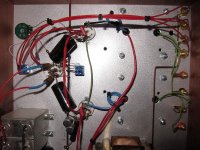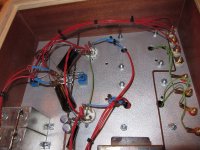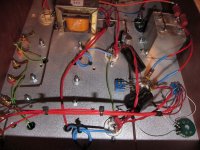Little dot pre amps are not to be use with direct coupled amps and I do understand why. Exactly how is one to know exactly which amps are direct coupled?
I have been told that most amps these day are direct coupled but, I do no know how true this is. Yes, I'm a bit confused over this born of my ignorance.
I ask this as I may get a Little Dot MKIII for headphone use.
However, I was wondering if I can also feed the LD output into an intergrated amp to boost low output sources such as an mp3 player.
What about T class amps? Are they considerd DC?
I have been told that most amps these day are direct coupled but, I do no know how true this is. Yes, I'm a bit confused over this born of my ignorance.
I ask this as I may get a Little Dot MKIII for headphone use.
However, I was wondering if I can also feed the LD output into an intergrated amp to boost low output sources such as an mp3 player.
What about T class amps? Are they considerd DC?
I have to assume that others are about as confused about this as I am.
Even on the LD forums, others can not get an answer to questions about DC amps.
Even on the LD forums, others can not get an answer to questions about DC amps.
Last edited:
Why? 😕Little dot pre amps are not to be use with direct coupled amps and I do understand why.
Open it up and look inside, study the schematic, or ask the manufacturer.Exactly how is one to know exactly which amps are direct coupled?
Why? 😕
Open it up and look inside, study the schematic, or ask the manufacturer.
I've been told that with a DC amp, if a valve fails on the LD, it can send high dc current to the speakers.
To be honest I thought that here, among the "experts" someone would know about the T amps. 🙂
BTW, if I was competent in reading schematics, I would already know the answer .😉
I guess we must all just be too stupid Joe......😀
"Class-T" isn't a class at all, it's a trademark for a now bankrupt company's class D amp chips.
If you want to know if an amp you've got is dc coupled, you could always try putting some dc into it - not too much mind, and watching what happens at the output with a meter.
"Class-T" isn't a class at all, it's a trademark for a now bankrupt company's class D amp chips.
If you want to know if an amp you've got is dc coupled, you could always try putting some dc into it - not too much mind, and watching what happens at the output with a meter.
If in doubt, you can always do the AC coupling yourself; just put a suitable capacitor between the Little Dot's output and the power amp's input.
I thought the Little Dot was a headphone amp? Surely it has to include a DC blocker at the output? I realise the LD is strange: I believe one version of it is simply a solid-state amp with a variable-mu cathode follower to add some distortion.
Aha! That's what I was suspecting. I guess they could leave out the output cap and use a DC servo or some other feedback arrangement to get rid of DC offset at the output, but I wouldn't want to own something like that.I believe one version of it is simply a solid-state amp with a variable-mu cathode follower to add some distortion.
If the valve fails the wrong way, you're screwed; there will be 100V or so on the output, and the feedback won't help. It's not just DC current through the speakers either; that kind of abuse would probably fry the input stage of a number of amps as well. (and an input coupling cap rated at 16V or so won't help either)
I understand that the different versions of the LD had quite different circuits, although details are hard to find. I saw on one website that someone had bypassed the CF and found that measured distortion roughly halved! (and it sounded better?)
As I said, even on the LD fourm there is confsion about the compatability of the LD amps when used as a preamp citing not to use them with a direct coupled amp. Even the moderators say "check with the amp's maufacture for compatabilty" to everyone who needs an answer..... never really adressing the issue.
BTW, I'm aware that T amps are a trade mark for amps using a Tripath chip but, they are a class of amps none the less with a certain architecture. My question was are they generally considered direct coupled designs.
I am interested in the LD MKIII.
BTW, I'm aware that T amps are a trade mark for amps using a Tripath chip but, they are a class of amps none the less with a certain architecture. My question was are they generally considered direct coupled designs.
I am interested in the LD MKIII.
Last edited:
The architecture of an amplifier will tell whether it is capable of being direct coupled, as not all are. If one is capable of being direct coupled then whether it is or not is a design decision so, as others have said, you have to ask about a particular amplifier or look at the circuit diagram. You have been given good advice.
The architecture of an amplifier will tell whether it is capable of being direct coupled, as not all are. If one is capable of being direct coupled then whether it is or not is a design decision so, as others have said, you have to ask about a particular amplifier or look at the circuit diagram. You have been given good advice.
That is probably the most informative explanation that have read anywhere on the subject. 🙂
That clears things up for me for the most part.
Last edited:
If in doubt, you can always do the AC coupling yourself; just put a suitable capacitor between the Little Dot's output and the power amp's input.
That's what I would do.
But there's always someone who's severely allergic to caps. 🙄
Direct coupling in different amps to be used with LD preamp
I am hoping people at this forum who are more knowledgeable than myself would help me determine if my amplifiers are of the direct coupling type or not. One is a modified Decware Zen design with EL84 power tubes and 6922 tubes in the preamplifier section, plus rectifier tube for the power (pictures attached). I am considering ordering LD Mk III or LD Mk IV which I plan to use mostly with active monitor speakers (Yamaha HS50M) but may wish to connect it to this Decware Zen clone or perhaps t-amp from Arjen Helder. Any thoughts which of these amplifiers/active monitor speakers might use direct coupling please?
I am hoping people at this forum who are more knowledgeable than myself would help me determine if my amplifiers are of the direct coupling type or not. One is a modified Decware Zen design with EL84 power tubes and 6922 tubes in the preamplifier section, plus rectifier tube for the power (pictures attached). I am considering ordering LD Mk III or LD Mk IV which I plan to use mostly with active monitor speakers (Yamaha HS50M) but may wish to connect it to this Decware Zen clone or perhaps t-amp from Arjen Helder. Any thoughts which of these amplifiers/active monitor speakers might use direct coupling please?
Attachments
Perhaps I should add that I also contacted the builder of the amp shown in previous message (still waiting for reply).
Peter
Peter
- Status
- Not open for further replies.
- Home
- General Interest
- Everything Else
- Little dot and direct coupled amps......


